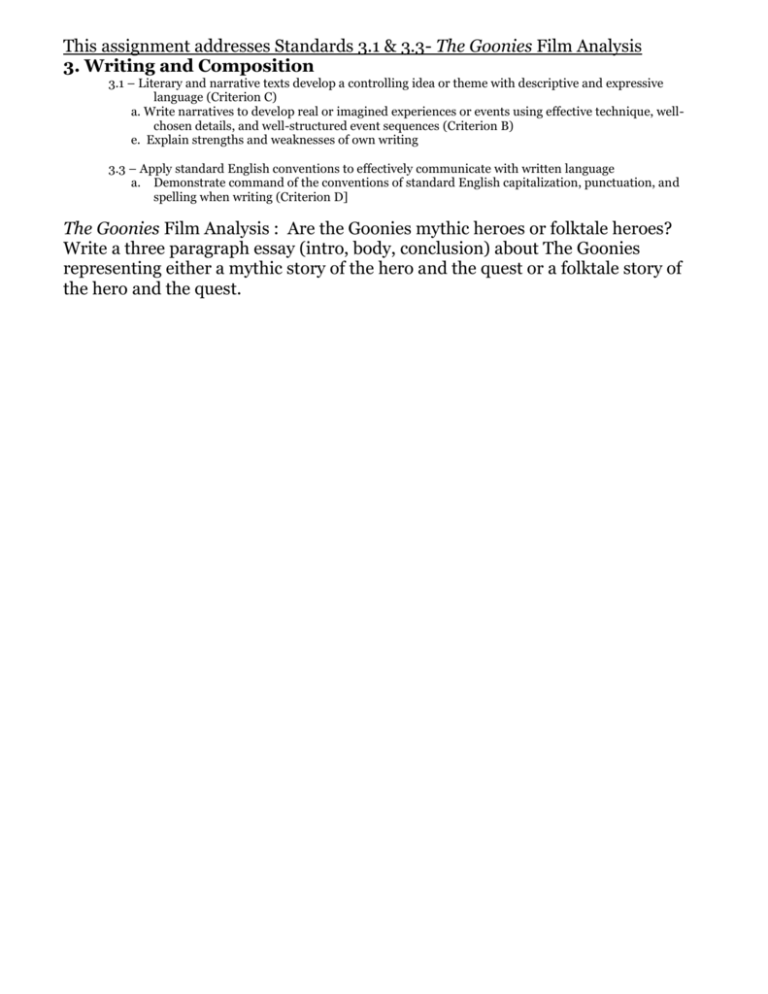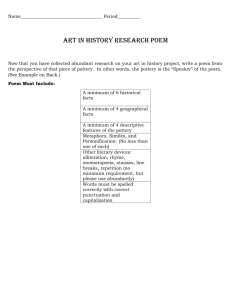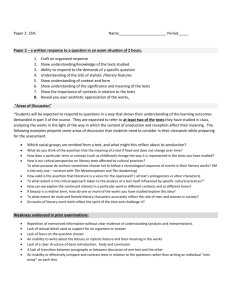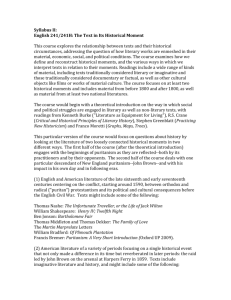Rubric
advertisement

This assignment addresses Standards 3.1 & 3.3- The Goonies Film Analysis 3. Writing and Composition 3.1 – Literary and narrative texts develop a controlling idea or theme with descriptive and expressive language (Criterion C) a. Write narratives to develop real or imagined experiences or events using effective technique, wellchosen details, and well-structured event sequences (Criterion B) e. Explain strengths and weaknesses of own writing 3.3 – Apply standard English conventions to effectively communicate with written language a. Demonstrate command of the conventions of standard English capitalization, punctuation, and spelling when writing (Criterion D] The Goonies Film Analysis : Are the Goonies mythic heroes or folktale heroes? Write a three paragraph essay (intro, body, conclusion) about The Goonies representing either a mythic story of the hero and the quest or a folktale story of the hero and the quest. MYP Criterion C: Producing Texts and Writing Standard 3.1 1. Produce texts that demonstrate insight, imagination and sensitivity while exploring and reflecting critically on new perspectives and ideas arising from personal engagement with the creative process. 2. Make stylistic choices in terms of linguistic, literary and visual devices, demonstrating awareness of impact on an audience. 3. Select relevant details and examples to develop ideas. Criterion Description Task-Specific Clarifications / Comments 3.5 - 4.0 The student: – Produces texts that demonstrate a high degree of personal engagement with the creative process; demonstrates a high degree of insight, imagination or sensitivity and perceptive exploration of and critical reflection on new perspectives and ideas. – Makes perceptive stylistic choices in terms of linguistic, literary and visual devices, demonstrating good awareness of impact on an audience. – Selects extensive relevant details and examples to develop ideas with precision. Write narratives that enhance and develop real or imagined experiences or events using consistently effective technique, well-chosen details, and wellstructured event sequences. i. Engage and orient the reader by setting out a problem, situation, or observation, establishing one or multiple point(s) of view, and introducing a narrator and/or characters; create a smooth progression of experiences or events. ii. Use a variety of techniques to sequence events so that they build on one another to create a coherent whole. Write literary and narrative texts using an elaborate range of poetic techniques, figurative language, and graphic elements to engage or entertain the intended audience effectively incorporating elements of myth or folktale Refine the expression of voice and tone in a text by selecting and using appropriate vocabulary, sentence structure, and sentence organization Review and revise ideas and development in substantive ways to improve the depth of ideas and vividness of supporting details Explain strengths and weaknesses of own writing and the writing of others using criteria 2.5 - 3.0 – Produces texts that demonstrate considerable personal engagement with the creative process; demonstrates considerable insight, imagination or sensitivity and substantial exploration of and critical reflection on new perspectives and ideas. – Makes thoughtful stylistic choices in terms of linguistic, literary and visual devices; good awareness of impact on an audience. – Selects sufficient relevant details and examples to develop ideas with precision. Write narratives to develop real or imagined experiences or events using effective technique, well-chosen details, and well-structured event sequences. 1. Engage and orient the reader by setting out a problem, situation, or observation, establishing one or multiple point(s) of view, and introducing a narrator and/or characters; create a smooth progression of experiences or events. 2. Use a variety of techniques to sequence events so that they build on one another to create a coherent whole. Write literary and narrative texts using a range of poetic techniques, figurative language, and graphic elements to engage or entertain the intended audience incorporating elements of myth and folktale. Refine the expression of voice and tone in a text by selecting and using appropriate vocabulary, sentence structure, and sentence organization Review and revise ideas and development in substantive ways to improve the depth of ideas and vividness of supporting details Explain strengths and weaknesses of own writing and the writing of others using criteria 1.5 - 2.0 – Produces texts that demonstrate adequate personal engagement with the creative process; demonstrates some insight, imagination or sensitivity and some exploration of and critical reflection on new perspectives and ideas. – Makes some stylistic choices in terms of linguistic, literary and visual devices; adequate awareness of impact on an audience. – Selects some relevant details and examples to develop ideas. Write narratives that minimally develop real or imagined experiences or events using effective technique, well-chosen details, and well-structured event sequences. Rarely writes literary and narrative texts using a range of poetic techniques, figurative language, and graphic elements to engage or entertain the intended audience and does not include elements of myth and folktale. Fails to explain strengths and weaknesses of own writing and the writing of others using criteria (e.g., checklists, scoring guides) .5 - 1.0 0 – Produces texts that demonstrate limited personal engagement with the creative process; demonstrates a limited degree of insight, imagination or sensitivity and minimal exploration of and critical reflection on new perspectives and ideas. – Makes minimal stylistic choices in terms of linguistic, literary and visual devices; limited awareness of impact on an audience. – Selects few relevant details and examples to develop ideas. The work does not reach a standard described by the descriptors. MYP Criterion D: Using Language and Writing Standard 3.3 1. Use appropriate and varied vocabulary, sentence structures and forms of expression. 2. Write and speak in a register and style that serve the context and intention. 3. Use correct grammar, syntax and punctuation. 4. Spell, write, and pronounce with accuracy. 5. Use appropriate non-verbal communication techniques. Criterion Description Task-Specific Clarifications / Comments 3.5 - 4.0 The student: – Effectively uses a range of appropriate vocabulary, sentence structures and forms of expression. – Writes and speaks in a consistently appropriate register and style that serve the context and intention. – Uses grammar, syntax and punctuation with a high degree of accuracy; errors are minor and communication is effective. – Spells/writes and pronounces with a high degree of accuracy; errors are minor and communication is effective. a. Demonstrates consistent command of the conventions of standard English capitalization, punctuation, and spelling when writing with 90100 percent accuracy. b. Produce clear and coherent writing in which the development, organization, and style are appropriate to task, purpose, and audience. c. Develop and strengthen writing as needed by planning, revising, editing, rewriting, or trying a new approach, focusing on addressing what is most significant for a specific purpose and audience. d. Use technology, including the Internet, to produce, publish, and update individual or shared writing products, taking advantage of technology’s capacity to link to other information and to display information flexibly and dynamically. 2.5 - 3.0 1.5 - 2.0 .5 - 1.0 – Uses a varied range of appropriate vocabulary, sentence structures and forms of expression competently. – Writes and speaks competently in a register and style that serve the context and intention. – Uses grammar, syntax and punctuation with considerable degree of accuracy; errors do not hinder communication. – Spells/writes and pronounces with a considerable degree of accuracy; errors do not hinder effective communication. – Uses an adequate range of appropriate vocabulary and forms of expression. – Sometimes writes and speaks in a register and style that serve the context and intention. – Uses grammar, syntax and punctuation with some degree of accuracy; errors sometimes hinder communication. – Spells/writes and pronounces with some degree of accuracy; errors sometimes hinder communication. – Uses a limited range of appropriate vocabulary and forms of expression. – Writes and speaks in an inappropriate register and style that do not serve the context and intention. – Uses grammar, syntax and punctuation with limited accuracy; errors often hinder communication. Demonstrate command of the conventions of standard English capitalization, punctuation, and spelling when writing with 80-90 percent accuracy. Produce clear and coherent writing in which each development, organization, and style are appropriate to task, purpose, and audience. Develop and strengthen writing as needed by planning, revising, editing, rewriting, or trying a new approach, focusing on addressing what is most significant for a specific purpose and audience. Use technology, including the Internet, to produce, publish, and update individual or shared writing products, taking advantage of technology’s capacity to link to other information and to display information flexibly and dynamically. Sometimes demonstrates command of the conventions of standard English capitalization, punctuation, and spelling when writing with 70-80 percent accuracy. Sometimes produces clear and coherent writing in which the development, organization, and style are appropriate to task, purpose, and audience. Sometimes develops and strengthens writing as needed by planning, revising, editing, rewriting, or trying a new approach, focusing on addressing what is most significant for a specific purpose and audience. – Spells/writes and pronounces with limited accuracy; errors often hinder communication. 0 The work does not reach a standard described by the descriptors.






